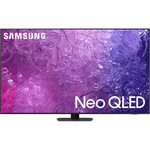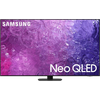A comparison of specs, key information, reviews, and best pricing from top retailers
Last updated -- hours ago | Report incorrect information
What we think

The PerfectRec TV team Learn more
Updated January 10, 2024·
For a premium viewing experience, particularly in bright rooms, the Samsung QN90C is an excellent choice due to its higher brightness and reflection handling. It's also well-suited for gaming, with faster response times and lower input lag, making it very responsive. However, it is more expensive. If you're looking for a more budget-friendly option, the Sony X77L costs less, although it may not perform as well in bright rooms and for gaming. It has lower brightness and contrast, which might affect its dark room performance, but it could still be a good fit for general TV watching and news. Give Feedback
this description is based on the product variant with some specs and product variant with some specs. At the time of writing, the variant with some specs cost some dollars and the variant with some specs cost some dollars.
Advantages of the Samsung QN90C (LCD)
- Best in class for bright room
- Good for dark room
- Very good for gaming
- Very good for movies & TV
- Good for sports
- Very good for news, talk, & other TV
- Very good for cartoons & animation
- Very good for use as monitor
- Very good for upscaling
- Excellent reflections
Advantages of the Sony X77L (LCD)
- Good viewing angle
Key differences
Picture Quality
8.1


5.6
7.38/10
CONTRAST
3.58/10
9.1/10
COLOR VOLUME SCORE
6.3/10
miniLED FALD
PANEL TYPE
LED
ADS / IPS
PANEL SUB-TYPE
IPS
The Samsung QN90C (LCD) has very good picture quality, while the Sony X77L (LCD) has poor picture quality.
Movies & TV
8.0


5.2
7.38/10
CONTRAST
3.58/10
6.8/10
BLACK UNIFORMITY
5.8/10
8.0/10
UPSCALING
7.0/10
Yes
HDR10 SUPPORT
Yes
Yes
HDR10+ SUPPORT
No
No
DOLBY VISION SUPPORT
No
The Samsung QN90C (LCD) is very good for movies & TV, while the Sony X77L (LCD) is poor.
Gaming
8.2


5.8
7.8/10
RESPONSE TIME SCORE
5.9/10
10.0/10
INPUT LAG SCORE
8.7/10
8.0/10
MOTION PROCESSING
8.5/10
75.0/100
GAMING LOCAL DIMMING
5.0/100
8.9/10
GAME HDR BRIGHTNESS SCORE
6.4/10
The Samsung QN90C (LCD) is very good for gaming, while the Sony X77L (LCD) is poor.
The Samsung QN90C is superior for gaming because it offers excellent response times and the lowest input lag, paired with a 120Hz refresh rate, which results in smoother and more responsive gameplay. In contrast, the Sony X77L has poorer response times and just a 60Hz refresh rate, which makes it less suitable for fast-paced gaming.
Cartoons & Animation
8.8


6.0
7.5/10
COLOR GAMUT SCORE
5.9/10
9.1/10
COLOR VOLUME SCORE
6.3/10
10.0/10
SDR BRIGHTNESS SCORE
7.2/10
8.1/10
COLORS OUT OF THE BOX SCORE
8.8/10
7.7/10
GRAY UNIFORMITY
7.7/10
The Samsung QN90C (LCD) is very good for cartoons & animation, while the Sony X77L (LCD) is only fair.
The Samsung QN90C is considered very good for watching cartoons and animation because it displays colors accurately straight out of the box and has a good color gamut, which means it can produce a wide range of colors vividly. On the other hand, while the Sony X77L also displays colors well out of the box, its color gamut is rated poor, suggesting it can't reproduce as wide a range of colors, leading to a fair performance in cartoons and animation.
News, Talk, & Other TV
8.8


6.0
10.0/10
SDR BRIGHTNESS SCORE
7.2/10
8.0/10
UPSCALING
7.0/10
The Samsung QN90C (LCD) is very good for news, talk, & other TV, while the Sony X77L (LCD) is only fair.
The Samsung QN90C excels in upscaling and SDR brightness, both crucial for watching news and TV shows, ensuring clear images and good visibility even in well-lit rooms. In comparison, the Sony X77L offers fair upscaling and lower SDR brightness, which might result in less sharp images and reduced visibility in bright conditions, affecting viewing experiences during day-time or in bright environments.
Bright Room
9.7


6.0
6.5/10
VIEWING ANGLE
7.7/10
10.0/10
SDR BRIGHTNESS SCORE
7.2/10
8.8/10
HDR BRIGHTNESS SCORE
6.2/10
9.0/10
REFLECTIONS SCORE
6.3/10
The Samsung QN90C (LCD) is best in class for bright room, while the Sony X77L (LCD) is only fair.
The Samsung QN90C is superior for viewing in a bright room due to its higher SDR and HDR brightness levels and excellent handling of reflections; meanwhile, the Sony X77L, with lower brightness and just fair reflection handling, will not perform as well under the same conditions. Although the Sony X77L has decent color volume and gamut, these advantages are overshadowed in bright environments where the Samsung's higher contrast and reflection management are more critical.
Cost
$1,299


$598
$0
$500
$1,000
$1,500
$2,000
The Samsung QN90C (LCD) has a price of $1,299 and the Sony X77L (LCD) costs $598.

Let Us Help Find Your Perfect TV
Find your new TV
Key similarities
Sports
7.0


6.8
8.0/10
MOTION PROCESSING
8.5/10
120Hz
REFRESH RATE
60Hz
10.0/10
INPUT LAG SCORE
8.7/10
8.0/10
UPSCALING
7.0/10
10.0/10
SDR BRIGHTNESS SCORE
7.2/10
Yes
HLG SUPPORT
Yes
Although they have very similar scores, PerfectRec considers Samsung QN90C (LCD) to be good for sports, while the Sony X77L (LCD) is only fair.
The Samsung QN90C outperforms the Sony X77L when watching sports due to its excellent response time and superior motion processing, which ensure fast-moving images are clear and smooth, and its reflection handling, which minimizes glare in bright rooms. However, the Sony X77L offers wider viewing angles, which could be a consideration if you often watch TV with a large group spread out across the room.
Give feedback
We’re constantly working to improve.
How the Samsung QN90C (LCD) and the Sony X77L (LCD) compare to other TVs
Spec Comparison
| Samsung QN90C (LCD) | Sony X77L (LCD) |
GENERAL | |||
|---|---|---|---|
| Price | |||
$1,299 | $598 | ||
Brand | |||
Brand | Samsung | Sony | |
Release Date | |||
Release Date | March 2, 2023 | July 4, 2023 | |
Full name | |||
Full name | QN65QN90C | KD-65X77L | |
Screen Size | |||
Screen Size | 65" | 65" | |
Screen Resolution | |||
Screen Resolution | 4K | 4K | |
TV FEATURES | |||
|---|---|---|---|
Operating System | |||
Operating System | Tizen | Google TV | |
Sound Quality Score | |||
Sound Quality Score | 8.3/10 | 6.1/10 | |
NextGen Ready | |||
NextGen Ready | Yes | No | |
HDMI Ports | |||
HDMI Ports | 4 | 3 | |
Coax Ports | |||
Coax Ports | 1 | 1 | |
DISPLAY QUALITY SCORES | |||
|---|---|---|---|
Picture Quality Score | |||
Picture Quality Score | 8.1/10 | 5.6/10 | |
Bright Room Score | |||
Bright Room Score | 9.7/10 | 6/10 | |
Gaming Score | |||
Gaming Score | 8.3/10 | 5.8/10 | |
Movies & TV Score | |||
Movies & TV Score | 8.1/10 | 5.2/10 | |
Sports Score | |||
Sports Score | 7/10 | 6.9/10 | |
PHYSICAL | |||
|---|---|---|---|
Dimensions w/o Stand (H x W x D) | |||
Dimensions w/o Stand (H x W x D) | 32.6" x 56.9" x 1.1" | 33.3" x 57.6" x 2.9" | |
Dimensions with Stand (H x W) | |||
Dimensions with Stand (H x W) | 35.1" x 56.9" | 36" x 57.6" | |
Weight without Stand | |||
Weight without Stand | 53.4 lbs | 45 lbs | |
VESA Mount | |||
VESA Mount | 400 x 400 | 300 x 300 | |
DISPLAY | |||
|---|---|---|---|
Color Depth | |||
Color Depth | 10 bit | 10 bit | |
Black Frame Insertion | |||
Black Frame Insertion | Yes | Yes | |
Auto Low Latency Mode | |||
Auto Low Latency Mode | Yes | Yes | |
Contrast | |||
Contrast | 7.4/10 | 3.6/10 | |
Local Dimming | |||
Local Dimming | 7/10 | 3/10 | |
SOUND | |||
|---|---|---|---|
Speaker Setup | |||
Speaker Setup | 4.2.2 | 2.0 | |
Speaker Power | |||
Speaker Power | 60 W | 20 W | |
Dolby Atmos | |||
Dolby Atmos | Yes | Yes | |
DTS:X | |||
DTS:X | No | Up to DTS Digital Surround, Bypass only | |
Shopping
Sony X77L (LCD)
See more
Dig into reviews and images
HDTVs and more
Milton Clark | September 2023
"For an entry-level model, Sony’s X77L is a decent 4K TV. It’s color reproduction, along with crisp and clean picture images revealed plenty of detail and clarity thanks in part to Sony’s excellent video processing."
Get a great deal on the Samsung QN90C (LCD) or the Sony X77L (LCD)
About Samsung
Samsung, a South Korean electronics manufacturer, holds the title of being the largest global TV vendor in terms of units sold. They offer a diverse lineup of TV products that cater to various budget ranges. A notable achievement in recent years is the development of Quantum Dots, a technology that enhances color reproduction, resulting in richer and more vibrant hues. Samsung TVs are well-regarded for their high manufacturing quality and user-friendly software, making them an excellent choice for consumers seeking an intuitive viewing experience.
About Sony
Sony stands as a highly experienced and widely trusted TV manufacturer, earning a reputation that surpasses all others. A Japanese company, Sony has been making TVs for far longs than it has been making Playstation game consoles. Sony's high-end TVs are often regarded as the ultimate choice for videophiles, representing the epitome of quality, albeit at a premium price point. Renowned for their advanced and precise motion handling, as well as their cutting-edge local dimming algorithms, Sony consistently delivers unparalleled performance in these areas. They include Google TV software with all their TV sets, which grants access to the largest selection of apps available and they also include Bravia Core which is a movie streaming platform specifically for Sony TVs that offers higher picture quality by using more bandwidth.
Give feedback
We're constantly perfecting our model
TV guides you might be interested in
More comparisons for you
FAQs
FAQs about TVs
Why trust us
This information was produced and vetted by the PerfectRec TVs team. We are a product research and recommendation organization that meticulously reviews and evaluates the latest TV information and makes it digestible for you.
By the numbers
385
TVs evaluated
33,110
TVs stats compiled
21
Proprietary TVs ratings developed
122,430
Recommendations made
18,365
Consumer hours saved
About the TV team
Joe Golden, Ph.D
CEO and TVs Editor
Joe is an entrepreneur and lifelong electronics enthusiast with a Ph.D in Economics from the University of Michigan.
Jason Lew
Staff Expert & Software Engineer
Jason is a staff expert and software engineer that has been making laptop recommendations for 7 years and moderates one of the largest laptop subreddits.
Chandradeep Chowdhury
Staff Expert & Software Engineer
Chandradeep is a staff expert and software engineer and expert in televisions and monitors. He’s been making monitor recommendations for ten years.
Jaime Roldán
TVs Expert
Jaime is a Colombia-based TV expert. He is an electronics engineer with 8 years of experience in the telecom sector and has been making TV recommendations for 12 years.







